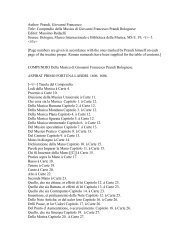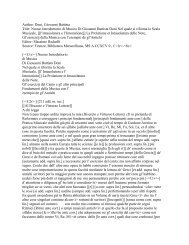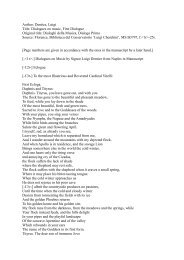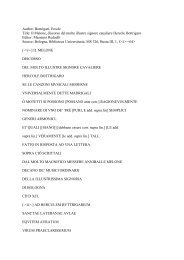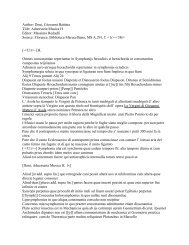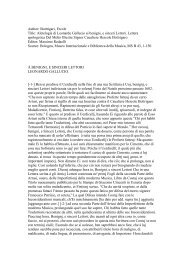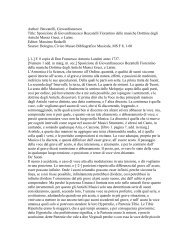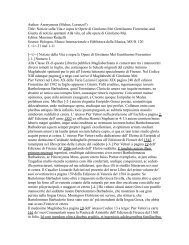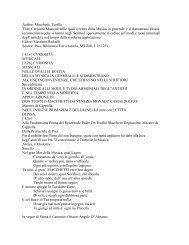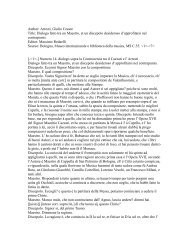Author: Doni, Giovanni Battista - manuscripts of italian music theory ...
Author: Doni, Giovanni Battista - manuscripts of italian music theory ...
Author: Doni, Giovanni Battista - manuscripts of italian music theory ...
You also want an ePaper? Increase the reach of your titles
YUMPU automatically turns print PDFs into web optimized ePapers that Google loves.
interval <strong>of</strong> the Diapason, five in the one <strong>of</strong> the Diapente and four in the one <strong>of</strong> the<br />
diatessaron (this is indicated by their names), and wanting that art should imitate<br />
nature, as it was reasonable, they used the tetrachords in these two man-made genera.<br />
However, Ptolemy, in the [[book]] twelfth chapter <strong>of</strong> the first book <strong>of</strong> his Harmonics<br />
defined [[that]] the Genus <strong>of</strong> Harmony as nothing but a certain [[proportion]]<br />
[position corr. supra lin.] which the notes which constitute the Diatessaron have with<br />
each other. Cleonides, in his Introduction (wrongly attributed in some texts to Euclid)<br />
[Aristides Quintilianus and, equally, Proclus in his Commentary on the Timaeus and<br />
Pappus in his Introduction (which is almost the same as Cleonides') in marg.] say<br />
more succinctly that the Genus is a certain and specific division <strong>of</strong> the Tetrachord.<br />
[This is the real reason why the ancients constituted the variety and difference <strong>of</strong> the<br />
genera within the Diatessaron, rather than because they considered it the first and last<br />
<strong>of</strong> the consonances as Salinas maintains in the first chapter <strong>of</strong> the third book in marg.]<br />
They were called genera with reason, because they contain many species within<br />
themselves, although the Enharmonic has only one, which does not matter, because it<br />
is not necessary, as the logics know well, that every genus should contain within itself<br />
many species. Thus, we see that there are two genera <strong>of</strong> animals, the Rational and the<br />
Irrational, the first one has no other specie than man, while the second has almost an<br />
infinite number. Now, it is not difficult to conjecture why the enharmonic is<br />
[monoeides] or <strong>of</strong> just one species, it is possible that this derived from the fact that<br />
they wanted to keep it more well regarded and in higher reputation [--] by<br />
keeping it simpler and uniform, or because, given its subtlety and minuteness <strong>of</strong><br />
intervals, was hardly capable <strong>of</strong> other divisions. [However, these genera proceed just<br />
as all the ancient say, namely, Aristoxenus, Ptolemy, Nicomachus, Aristides<br />
Quintilianus, Pappus, Cleonides, Proclus [Bacchius add. supra lin.] on Plato's<br />
Timaeus. [[Now]] The Diatonic proceeds in his four voices <strong>of</strong> the Tetrachord in this<br />
way: first there is a semitone and then two tones one after the other going from the<br />
low register to the high register as one has always to proceed. The Chromatic moves<br />
through two Semitones or half tones and a semiditone (minor third), which was called<br />
trihemitone by the ancients, namely made <strong>of</strong> three uncompounded semitones. The<br />
word uncompounded refers to an interval which is not divided in that particular genus.<br />
[As Aristides states, as well as Boethius in his first book, and others in marg.] The<br />
Enharmonic proceeds through two Dieses or quarters <strong>of</strong> a tone and a Ditone (major<br />
third) uncompounded.<br />
Which Melodies are said s<strong>of</strong>t and which hard [[chapter]] and what is called thick and<br />
not thick. Chapter<br />
Ptolemy says, in the mentioned chapter, that the first division <strong>of</strong> the genera is done<br />
into s<strong>of</strong>t and hard. It seems to me that this is the best way to express what they call<br />
[syntonon] that with the term 'combination <strong>of</strong> sounds', as other do, since this words<br />
means more a style <strong>of</strong> timing fast and furious that what the Greeks mean. As s<strong>of</strong>t<br />
Genera they intended the genera that [--] contain intervals which are smaller<br />
than the ordinary, such as the Chromatic and the Enharmonic, while as hard genus<br />
they meant one that has intervals that are no smaller and minute than those that are<br />
sung naturally, so the hard genus comes to be the Diatonic. [[Then]] we must know<br />
[see Ptolemy in the chapter quoted in marg.] that what the Greeks call [pyknon],<br />
namely think, dense, busy, or made up <strong>of</strong> small intervals, it is typical <strong>of</strong> the Chromatic<br />
and Enharmonic, because it is not part <strong>of</strong> the Diatonic. They used to call thick [as<br />
Aristoxenus says and Aristides after him, and the others in marg.] (we ill use this



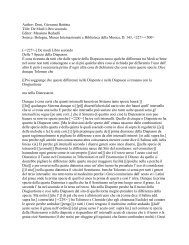
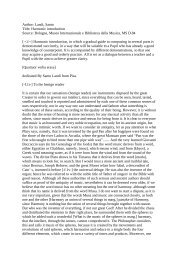
![Doni, Giovanni Battista Title: Trattato Dei Tuoni o [[Harmonie de]]](https://img.yumpu.com/45461005/1/190x245/doni-giovanni-battista-title-trattato-dei-tuoni-o-harmonie-de.jpg?quality=85)
